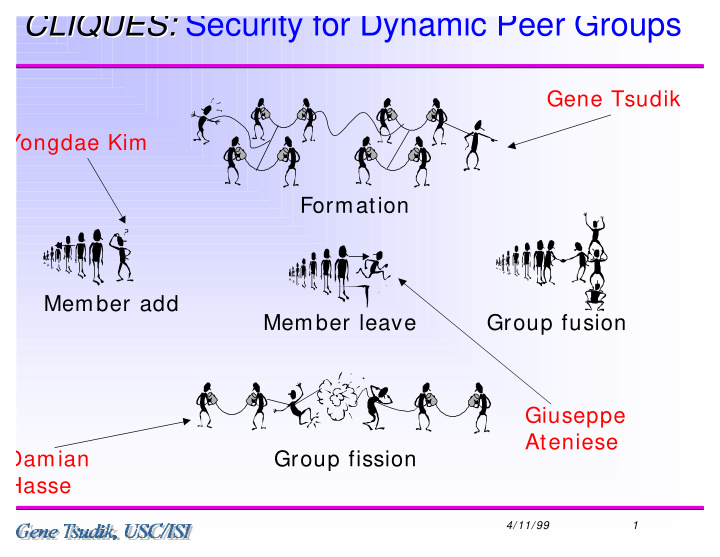



CLIQUES: Security for Dynamic Peer Groups CLIQUES: Gene Tsudik Yongdae Kim Formation Member add Member leave Group fusion Giuseppe Ateniese Damian Group fission Hasse 4/ 11/ 99 1
Background Targeted environment • Relatively small groups • Dynamic membership • No hierarchy • Many-to-Many • Collaborative applications Problem: how to obtain security in peer groups with dynamic membership and decentralized dynamic decentralized control? 4/ 11/ 99 2
Security Services Provided • Decentralized authenticated group key agreement with provable security based on group Diffie-Helman: each member contributes equally to group key • Membership changes: single member, many members and sub-groups • Membership authentication: based on knowledge of key-share • Authenticated join/ leave: requires long-term DH credentials Other pieces of the puzzle • Certification infrastructure • Reliable group communication subsystem • Membership Authorization / Access control 4/ 11/ 99 3
STATUS • Initial Key Agreement [ stw96] • Auxiliary Key Agreement (membership changes) [ stw98] • Authenticated Key Agreement [ ast98] • JAVA implementation (rel. 0.0) • C implementation (rel. 0.1) coupled with JHU’s SPREAD • CLQ_API: coding completed (rel. 1.0) mid-Feb • Testing and integrating with SPREAD [ tbd99] • Current performance results (0.024sec/ exp!!! Yuck...) • Integration with TOTEM on-going (LBL) • Integration with AKENTI: near future 4/ 11/ 99 4
Proposed Architecture 4/ 11/ 99 5
CLQ_API prerequisites Underlying group communication subsystem must provide reliable synchronized event notification for: • group joins • group leaves • partitions • node failures or disconnects • merges (partition heals) merges (partition heals) 4/ 11/ 99 6
CLQ_API called by a new group member who received a NEW_MEMBER message from the current controller. clq_ join (ctx, member_name, group_name, input, output); clq_ join called by the current controller to hand over group context to a new member (who becomes next controller). clq_ pass_ ctx (ctx, member_name, output); clq_ pass_ ctx called by every member upon reception of a KEY_UPDATE_MESSAGE from the current group controller clq_ update_ ctx (ctx, input); clq_ update_ ctx 4/ 11/ 99 7
CLQ_API (contd) called by every group member after member leaves or partition occurs; removes all valid members in member_list from the group_member_list. Only controller gets output token clq_ leave (ctx, member_list[ ] , output); clq_ leave called only by controller when group_secret needs to be updated. clq_ refresh_ key (ctx, output); clq_ refresh_ key 4/ 11/ 99 8
Almost done... Lessons learned, challenges and directions: • Paper protocols < > real protocols • Incremental formation of groups • Security, group comm not a simple composition • Difficulty of handling many merging sub-groups • Group size limits (100?) • other DH-like keys • elliptic curve duals • Two-tiered groups (few senders, many receivers) • Group membership policy (Auth + AC) • Group certification: group key, membership, etc. • Dynamic membership? • Individual vs opaque certificates? 4/ 11/ 99 9
Last chart... Tech Transfer: • IBM • JHU • LBNL (DoE) • IRTF-> IETF? CLIQUES web page: http: / / www.isi.edu/ div7/ cliques • API documentation • Publications • Presentations API code by request from gts@isi.edu Collaborators: • IBM Research, Johns Hopkins, LBNL, Nortel 4/ 11/ 99 10
Secure Spread SD 4/ 11/ 99 11
Recommend
More recommend